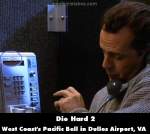
Factual error: The payphone McClane uses in Dulles airport has the "Pacific Bell" logo. Pacific Bell is a West Coast phone company. (00:04:20)
Factual error: Near the beginning of the film when John McClane goes to the pay phone and calls his wife Holly on the airplane, that was impossible at the time. Those phones you see on the seats on the plane can only be used from the air to the ground not the other way around. Holly does answer on the plane phone and not on any cell phone she had in her purse. Not to mention even if it was possible to call the planes from the ground, they could do that to warn them of what's going on below and prevent more crashes. (00:04:20)
Factual error: When McClane (Bruce Willis) is brought into Capt. Lorenzo's (Dennis Franz) office at Dulles Airport for the first time, Lorenzo mentions that McClane was in violation of several District of Columbia laws. Dulles Airport is in Virginia, not DC, therefore any DC laws would not apply to Dulles. (Although VA may very well have similar laws about airport misconduct.) (00:19:55)
Factual error: In the scene where Bruce Willis faxes the finger prints of Oswald Cochrane to Sgt. Al Powell in LA, I don't see how you can determine the prints through a fax. They would appear as blobs on the other end, especially with faxes of that era. (00:24:45)
Factual error: Just before Col. Stewart activates his equipment, we can see one of his men working with a welding torch on telecommunication equipment. You can't patch telco connections using a welder. (00:28:50)
Factual error: There is absolutely no way the villains could remotely recalibrate the instruments on the plane itself. Even if it would be possible to remotely readjust the ILS glideslope - which it isn't - the pilot would've noticed their approach angle being suspiciously steep on the attitude indicator and the aircraft's radar altimeter would've given a terrain warning. (00:52:44)
Factual error: When the terrorist clears the nearly fuel-exhausted plane to land on the lowered ILS, the terrorist says, "Windsor 114, you are cleared to land on Dulles Runway 29, ILS." Problem is: There is no Runway 29 at Dulles. The closest runway alignment for a 290 degree heading is Runway 30. (00:53:35)
Suggested correction: Runway numbers are based on the magnetic heading of the runway, and since the earth's magnetic field is in constant motion, a runway's magnetic heading can and does change over time. As an example, my local airport's main runway is 30/12, but 10 years ago it was numbered 31/13. Therefore, it is possible that in 1990, what is now runway 30 at Dulles was numbered 29.
Random guesswork isn't a valid correction. A simple google search will show that runway 30 at Dulles has been called that since it was opened in 1962. In 1990 there were 3 runways at Dulles: 1C/19C, 1R/19L, and 12/30.
Factual error: At the time Die Hard 2 was made the only people in the Army that wore black berets were Rangers. If anything an SF (Green beret) team would be responsible for providing aid in that situation. (01:03:15 - 01:28:15)
Factual error: The terrorists are using Kenwood 46AT Handheld Radios that operate on 440Mhz. The Army moves in with a Kenwood TS-850 Radio that operates on 30Mhz-3Mhz. Nowhere near the frequency that the terrorists are using. (01:11:30 - 01:25:40)
Factual error: There is no airport in the world with a manhole cover in the middle of a runway. (01:14:00)
Factual error: The plane from which Bruce Willis escapes by using an ejector seat is a non-existing plane. The fuselage is from an old transport plane from the US Air Force made by Chase. But there has never been a Chase with 4 engines buried in the wing. America uses underslung engines. In this case, it is the wing of an Arado Blitz prototype from the second world war and the fuselage of a Chase cargo plane. (01:15:10)
Factual error: The chase scene involving the snowmobiles is problematic in that McClane can actually see where he's going. In driving snow, it's often difficult to see, as snow blows in one's eyes. On a speeding snowmobile, in heavy snow and with no eye protection, it would be practically impossible to see anything. (01:31:15)
Factual error: Firing a full magazine of blank cartridges from an automatic weapon in the police station office as McClane does would be painfully loud. Nobody shows the slightest effect - nobody even winces. Some of the men wince slightly but their reaction is grossly underplayed. Obviously the sound was looped in later. (01:37:40)
Suggested correction: Every person jumps/winces and cowers out of the way of the bullets, one other officer even draws his gun in response.
What has never made any sense to me about this is that in a room full of cops everyone just stands around watching McClane seemingly gun down their Chief and only one officer even bothers to draw his gun.
Probably because everyone hates the chief. I wondered about that too.
Suggested correction: What makes the loud bang from guns is not the explosion of the gunpowder, but the bullet itself breaking the sound barrier as it leaves the gun. It's very noticeable when a gun fires a blank because it's so much quite, as the only sound is the small pop of the gunpowder inside. It's little more than the sound of a firecracker, but even more muffled by being inside metal.
I have shot blank and live with the military. Both are loud, but sound different. More of a crack with live.
Blanks are very loud: https://www.youtube.com/watch?v=z6PESH5LSE0.
Factual error: After the fight with Colonel Stuart on the wing of the plane, Bruce Willis falls down from the wing. As he falls, watch the tyre-tracks near him. Those are definitely NOT the tyre-tracks of a plane. A jeep or a truck, maybe, but not a plane. (01:44:45)
Factual error: When McClane lights the fuel with the zippo, the flame trail is all wrong. There appears to be a thin strip of fuel which accelerates away from him. However, we have seen the Fuel spurted out in a wider less controlled manner from a wing tip that has to be at least fifteen feet up, in a wind, which would have sprayed it around further. There is no way it would light in the tight manner shown. (01:45:55)
Suggested correction: The fuel would not light at all, so the tightness of its trail is really unable to be determined in this manner. Assuming jet fuel could light like that, it's possible that only the densest area would be able to catch, which would be the center of the trail... but again, Jet A is pretty hard to catch on fire.
Factual error: When the bad guys 747 is blown up it is about 40 or 50 metres off the ground and travelling at take-off velocity, yet when Holly's plane is landing you can see that the debris field is perfectly circular. Surely the 747s speed and angle of descent would mean the debris field would be elongated? (01:50:30)
Factual error: When the 747 explodes, fire is rushing up through the cargo hold. Esperanza - in the cockpit - looks back over his shoulder as if seeing the fire coming. Clearly he can't see the fire - since the view we are seeing is inside the cargo hold and cabin. But why is he then turning his head and looking back against the cockpit wall? And the flash we see on his face - from the explosion - that would not be there until the fire was inside the cockpit. And that would go so fast that he wouldn't have time to scream. (01:50:35)
Factual error: When Holly's plane finally lands, the cockpit shot shows the pilot with his hands on four engine throttles. But Holly's plane is an L-1011 TriStar, which only has three engines. (01:52:00)
Factual error: The exchanges between the bad guy pretending to be an air traffic controller and the pilot of the doomed aircraft are not even close to realistic. Air traffic control communication is almost its own language. The FAA handbook says, in part: "Brevity is important, and contacts should be kept as brief as possible. Jargon, chatter, and 'CB' slang have no place in ATC communications."
Factual error: Transport aircraft do not have ejection seats; only fighters, bombers, and attack aircraft have them.






Suggested correction: If the pilots are given an incorrect altimeter setting (outside barometric pressure), then yes, they can be fooled as to their altitude.
Even if the pilots would've been given an incorrect QFE for the barometric altimeter, the radio altimeter would've still given the correct altitude, and there's nothing the bad guys could do to mess with it.